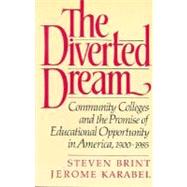The Diverted Dream Community Colleges and the Promise of Educational Opportunity in America, 1900-1985

The Diverted Dream Community Colleges and the Promise of Educational Opportunity in America, 1900-1985
- ISBN 13:
9780195048155
- ISBN 10:
0195048156
- Format: Hardcover
- Copyright: 09/07/1989
- Publisher: Oxford University Press
- Newer Edition
Rent
Sorry, this item is currently unavailable on Knetbooks.com
Note: Supplemental materials are not guaranteed with Rental or Used book purchases.
Extend or Purchase Your Rental at Any Time
Need to keep your rental past your due date? At any time before your due date you can extend or purchase your rental through your account.
Summary
In the twentieth century, Americans have increasingly looked to the schools--and, in particular, to the nation's colleges and universities--as guardians of the cherished national ideal of equality of opportunity. With the best jobs increasingly monopolized by those with higher education, the opportunity to attend college has become an integral part of the American dream of upward mobility. The two-year college--which now enrolls more than four million students in over 900 institutions--is a central expression of this dream, and its invention at the turn of the century constituted one of the great innovations in the history of American education. By offering students of limited means the opportunity to start higher education at home and to later transfer to a four-year institution, the two-year school provided a major new pathway to a college diploma--and to the nation's growing professional and managerial classes. But in the past two decades, the community college has undergone a profound change, shifting its emphasis from liberal-arts transfer courses to terminal vocational programs. Drawing on developments nationwide as well as in the specific case of Massachusetts, Steven Brint and Jerome Karabel offer a history of community colleges in America, explaining why this shift has occurred after years of student resistance and examining its implications for upward mobility. As the authors argue in this exhaustively researched and pioneering study, the junior college has always faced the contradictory task of extending a college education to the hitherto excluded, while diverting the majority of them from the nation's four-year colleges and universities. Very early on, two-year college administrators perceived vocational training for "semi-professional" work as their and their students' most secure long-term niche in the educational hierarchy. With two thirds of all community college students enrolled in vocational programs, the authors contend that the dream of education as a route to upward mobility, as well as the ideal of equal educational opportunity for all, are seriously threatened. With the growing public debate about the state of American higher education and with more than half of all first-time degree-credit students now enrolled in community colleges, a full-scale, historically grounded examination of their place in American life is long overdue. This landmark study provides such an examination, and in so doing, casts critical light on what is distinctive not only about American education, but American society itself.









